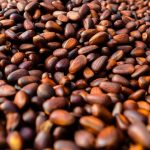
Fumaric acid has many functions throughout industry. It is a natural plant substance and was named after the genus Fumaria. The genus are important herbs known as the fumitorys. It is an important biochemical intermediate being a key component in the Krebs or Tricarboxylic Acid Cycle (TCA Cycle).
Alternative Names
It is chemically known as trans-2-butendioic acid, trans-1,2-ethylenedicarboxylic acid, allmaleic acid and boletic acid. The general structure is (COOH-CH=CH-COOH).
It is manufactured by isomerising malic acid or by fermentation.
Food Use
Fumaric acid generates a sour taste in food without the puckering effect seen with citric acid. It is often used in combination with other food acids where it forms an effective flavouring blend. For many though it is one of the strongest acids which is a difficult concept to overcome. The FDA in the USA approved its use as an acidifier, curing accelerator and flavouring agent.
The acid is extensively used in fruit juice beverages, desserts especially ones using gelatin, pie fillings, biscuit doughs which are often chilled and refrigerated, maraschino cherries and some wines.
It is also used for preparing various edible coatings for confectionary and candy, water-in-oil emulsions, reconstituted fats and dough conditioners.
It has reasonable solubility in water but is the least soluble of the food acids available. It is also hygroscopic. The relatively low solubility makes it useful in some applications. In noncarbonated fruit juice drinks, its greater acid strength means lower levels of citric acid are needed. It is strongly resistant to absorption of moisture from the atmosphere and so is usually found as the acid of choice in dry mix products. The rate of solubilising of fumaric acid is low but it appears to increase as the particle size gets smaller.
The acid is used in gelatin desserts because it improves their flavour stability and gel strength.
Fumaric acid is a strong antioxidant. It is added to foods to prevent the onset and development of rancidity in butter, lard, fats, oil-based products, powdered milk, bacon, sausage, nuts and potato chips and fries.
As an antimicrobial, it can complement benzoic acid (sodium benzoate) as a preservative in fresh plant foods and fish products. It is often added to wines to prevent malolactic fermentation because it is toxic to lactic acid bacteria at acidic pHs. It is also added to create a certain acidity in wine and is even a clarifying agent although there are few applications using it.
The Salts Of Fumaric Acid
Sthe esters of fumaric acid, the fumarates are often seen in foodstuffs
Sodium stearyl fumarate is a dough conditioner in yeast-leavened baked products. The level of use must not exceed 0.5% by weight of the flour. It also serves as a conditioning agent in dehydrated potatoes and processed cereals for cooking. The maximum level in such foods must be less than 1% by weight. It also serves the same function in flour- or starch-thickened foodstuffs and must bot exceed 0.2% by weight of the food. It is a stabilising agent in non-yeast leavened baked products where it is permitted to a level upto 1% by weight of the flour.
The agent is used as a component of glues and adhesives, resins and polymeric coatings, paper and paperboard in contact with dry foods, and in single-use and repeated-use food contact surfaces.
Toxicity
Fumaric acid has a very low acute chronic toxicity. Long-term oral administration of fumaric acid produce no ill effects in rats at a concentration of 1.2% in the diet, in guinea pigs at 1.0% and in dogs at 5%.

Leave a Reply